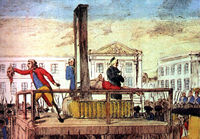Execution
of Louis XVI
21 January 1793
 Whatever
can be said of Louis XVI's performance
during his reign and the early parts of the French Revolution, there
can be no doubt he died bravely and like a king. Whatever
can be said of Louis XVI's performance
during his reign and the early parts of the French Revolution, there
can be no doubt he died bravely and like a king.
He
met his fate only a day after the National Convention condemned
him to death and only hours after saying goodbye to his queen Marie-Antoinette
and their children the previous night. It had taken two hours for
a large escort of cavalrymen to bring him to the Place de la Revolution
through a massive crowd that had gathered to witness the historical
moment.
Journeying in the green carriage with Louis XVI was an English priest,
Henry Edgeworth, who gave him a book of psalms to read.
According
to Edgeworth's description of the proceedings the carriage stopped
in the middle of a large space left around the scaffold. Surrounding
that were cannons and further away "an armed multitude extended
as far as the eye could reach."
As
the guards prepared to get out Louis stopped them and said "I
recommend to you this good man (Edgeworth); take care that after
my death no insult be offered to him - I charge you to prevent it."
Then
he alighted and three soldiers moved to take off his brown coat
to prepare him for the blade.
Edgeworth
said: "But he repulsed them with haughtiness - he undressed
himself, untied his neckcloth, opened his shirt, and arranged it
himself."
Then
the guards, who for a while were taken aback, then surrounded him
again and moved to seize his hands. The indignant king fought them
off, but was calmed by Edgeworth.
The
priest's description of the next moments of the execution are particularly
moving.
"The
path leading to the scaffold was extremely rough and difficult to
pass; the King was obliged to lean on my arm, and from the slowness
with which he proceeded, I feared for a moment that his courage
might fail; but what was my astonishment, when arrived at the last
step, I felt that he suddenly let go my arm, and I saw him cross
with a firm foot the breadth of the whole scaffold."
Edgeworth
said that "by his look alone" the crowd was silenced and
then the king spoke in a loud voice: "I die innocent of all
the crimes laid to my charge; I pardon those who have occasioned
my death; and I pray to God that the blood you are going to shed
may never be visited on France."
Edgeworth
continued: "He was proceeding, when a man on horseback, in
the national uniform, and with a ferocious cry, ordered the drums
to beat."
"Many
voices were at the same time heard encouraging the executioners.
They seemed reanimated themselves, in seizing with violence the
most virtuous of Kings, they dragged him under the axe of the guillotine,
which with one stroke severed his head from his body. All this passed
in a moment."
"The
youngest of the guards, who seemed about eighteen, immediately seized
the head, and showed it to the people as he walked round the scaffold;
he accompanied this monstrous ceremony with the most atrocious and
indecent gestures."
It
should be noted that in another description of the execution a witness
describes it taking two drops of the guillotine to sever Louis'
head, due to the corpulence of his neck.
The
time of death of France's king was 10.15am, five-and-a-quarter hours
after he rose from his bed.
Other
reports have members of the crowd dipping material into the king's
blood that ran from the scaffold so they could keep them as souvenirs.
After
his death Louis' body was taken to the cemetery at the Church of
the Madeleine where it put into a large pit, close to the wall of
the Rue d’Anjou, and then smothered in quicklime.
French
Revolution Posters
|



